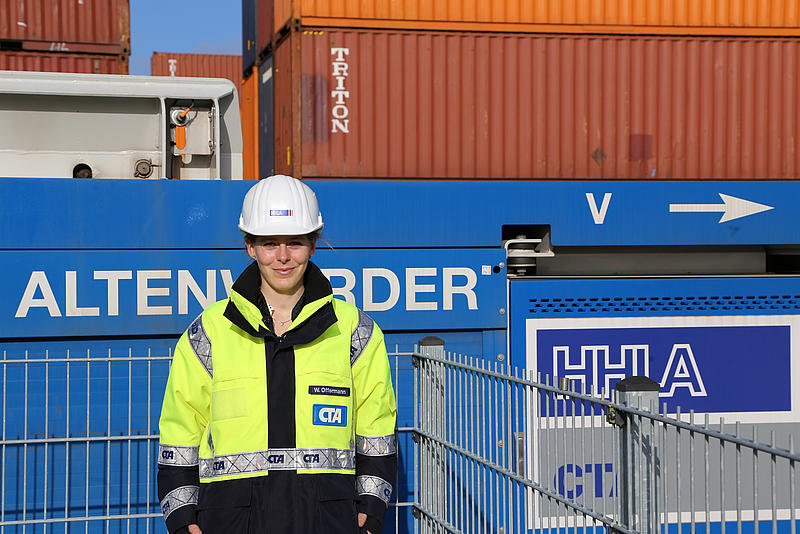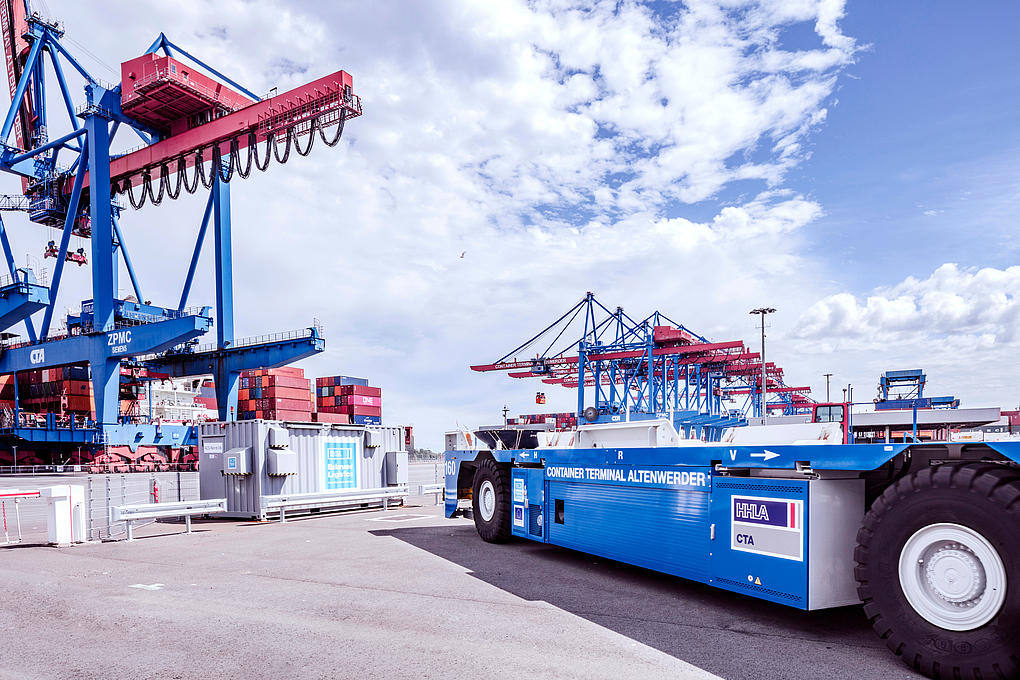FRESH: stable grid due to AGVs
The FRESH research project has begun at the climate-friendly container handling facility HHLA Container Terminal Altenwerder (CTA). The battery capacities of the automated guided container transport vehicles (AGVs) are to be integrated into the German energy network as flexible storage units and contribute to the grid stability of the power supply.
One of the greatest challenges of the energy transition is ensuring grid stability. If more solar or wind energy is used, for instance, there could be fluctuations due to differing wind strength or solar radiation levels. These fluctuations must be absorbed to ensure a stable grid frequency.
FRESH can help solve this problem. In partnership with Next Kraftwerke GmbH, one of the largest virtual power plant operators in Europe, HHLA is investigating the extent to which the roughly 100 AGVs at CTA can contribute to grid stability. In less busy times, free AGVs could provide battery capacity with their fast-charging lithium-ion batteries as mobile power stores, helping to guarantee a stable frequency of 50 hertz (Hz) on the power grid.
Container transporters as mobile power stores.
One of the greatest challenges of the energy transition in Germany is the safeguarding of grid stability. By now, the share of renewable energy sources in the German electricity mix is more than 40 percent¹. This development requires technical solutions by the network providers so that companies and private consumers may soundly be supplied with electricity at all times. One of these solutions could be FRESH, which stands for flexibility management and control reserve provision of heavy goods vehicles in the harbour.

Fluctuations must be absorbed
As opposed to power stations driven by fossil fuels, which can provide electricity on demand, this is not guaranteed with renewable energies. Weather-dependent energy sources like wind and sun are not always available. This leads to fluctuations that must be absorbed in order to guarantee a consistently secure supply and a stable frequency of 50 hertz (Hz) on the power grid.
An example of what happens when the supply frequency deviates too greatly from the 50 Hz norm was apparent in spring 2018. Small fluctuations a year ago resulted in radio alarms and stove clocks running late. As a result, all over Europe people were late to school and work since the time they assumed was right was actually incorrect. When deviations from the supply frequency are too far from the ideal value, the worst case is a collapse of the power supply – a blackout.
Virtual power plants are intended to offset the fluctuations. They digitally link various energy producers and consumers and bundle the offers and needs of the participants. If, for example, a solar park cannot deliver adequate electricity due to weather conditions, a bioenergy plant will power up energy production at the same time. If the wind is blowing particularly hard, stationary energy storage systems can store the surplus power.
Pioneering work in the field of grid stability
Now, for the first time, Hamburger Hafen und Logistik AG and Next Kraftwerke GmbH, one of the largest virtual power plant operators in Europe, are investigating the extent to which industrially used mobile battery capacities can be connected to the German power grid so that primary control reserves² may be rendered for grid stability under economic conditions. Terminal operations may not be impaired by this.
Since 2022, the approximately 100 AGVs in use at Terminal Altenwerder for the transport of containers have been completely converted to fast-charging lithium-ion batteries, which is supported financially by the European Regional Development Fund (ERDF). In purely mathematical terms, they could provide 4 megawatts for the energy market at the 18 electric charging stations.

Rethink. Think further. Think ahead.
How can we shape the future of logistics? Discover how innovative solutions and technologies are paving the way for more efficient and sustainable logistics.
Innovation at HHLAFree AGVs could be used as mobile power stores
“This is, of course, not their primary purpose – container transport is. But in less busy times, free AGVs could provide battery capacity as mobile power stores to safeguard grid stability,” says Wiebke Offermann.
With Next Kraftwerke, the OFFIS Institute for Information Technology in Oldenburg and the University of Göttingen, HHLA is developing within the three-year FRESH project a process and software solution for accessing the power market. The research project, which is funded by the German Federal Ministry for Economic Affairs and Energy as part of the “IKT for Electromobility III” technology programme and receives subsidies of approximately € 1.4 million, will digitally control the demands of the virtual power plant operator and smooth terminal operations.
“Capacity utilisation at the terminal determines whether AGV capacities are free. These in turn depend on such factors as ship schedules, weather and tide conditions, traffic volume and loading cycles of the AGVs,” explains Wiebke Offermann. All these parameters must be included in order to develop reliable, efficient and, especially, automated processes. “In this way, we can predict quite precisely when and how long AGVs can dock at the electric charging stations, in order to either give or receive energy when the power grid requires it.”
¹ Annual evaluation of electricity generation by the Fraunhofer Institute for Solar Energy Systems.
² In order to retain normal frequency of 50 hertz in the Federal Republic’s power grid at all times, the four German transmission system operators need a tool that can balance unforeseen fluctuations in a matter of seconds. This tool is the primary reserve that must be available within 30 seconds to prevent power failure. The primary reserve is thus the first control power to be activated and the immediate step in case of deviation in the supply frequency.